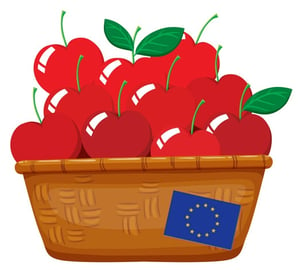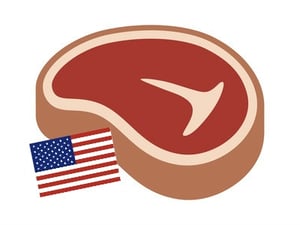 European apples and pears for the USA - Draft rule paves the way for EU exports of apples and pears to the US! This is a great example of what goes on behind the headlines in negotiations between the European Union and the Unites States of America regarding the Transatlantic Trade and Investment Partnership (TTIP). The TTIP negotiations kicked off in 2013 and so far 11 rounds have taken place, the last one in Miami in October 2015. The EU request to the US Department of Agriculture (USDA) to simplify market access for fruit growers, covers only eight EU Member States (Belgium, Germany, Spain, France, Italy, the Netherlands, Poland and Portugal).
European apples and pears for the USA - Draft rule paves the way for EU exports of apples and pears to the US! This is a great example of what goes on behind the headlines in negotiations between the European Union and the Unites States of America regarding the Transatlantic Trade and Investment Partnership (TTIP). The TTIP negotiations kicked off in 2013 and so far 11 rounds have taken place, the last one in Miami in October 2015. The EU request to the US Department of Agriculture (USDA) to simplify market access for fruit growers, covers only eight EU Member States (Belgium, Germany, Spain, France, Italy, the Netherlands, Poland and Portugal).
The original application actually dates from 2007, but the context has moved on since and is now more urgent as EU fruit growers have been hit hard by Russian sanctions imposed in 2014 in response to the Ukraine situation: Poland and Belgium, for example, lost 50% of their exports. It is worth knowing that Russia was the #2 (€9.1 billion) destination market for EU agricultural products, after the US #1 (€16.4). In robust language, delivering concrete advantage for EU fruit producers, the EU Commission statements reads “we are looking forward to the rapid completion of the remaining legal and administrative steps in order to deliver further tangible benefits for the EU fruit producers. Opening the market for the 2016 harvest i.e. by September 2016 could be feasible, if all parties continue their efforts."
EU trade in agricultural products with the USA is big business for both parties, representing over €27 billion ($18.3 billion) of bi-lateral trade, tens of thousands of businesses and many hundreds of thousands of jobs. From an EU perspective the trade represents €16.4 billion of exports and €10.3 billion of imports, providing a very healthy €6.1 billion positive balance of trade (2014 figures). For more information check out: European Commission, Directorate-General for Agriculture and Rural Development, “Agri-Food Trade Statistical Fact Sheet”, dated 10.2015. The document is indeed a factsheet, with very useful details on EU agri-food exports to the US. Overall tariffs on trade between the EU and the US are generally low (+/-5%), yet they are still relatively high for food and agricultural goods (EU imports of US cereals (18%) and milk (50%)), applying what are known as tariff-rate quotas (TRQs). Most importantly for barriers to agri-trade are the non-tariff measures (NTMs) that are especially prevalent for many agricultural commodities. Tariffs, TRQs and NTMs are the nuts and bolts of the TTIP negotiations and understanding their potential impacts on food and agricultural trade, is essential for those businesses and jobs.
 There are many European stakeholders in the agri sector that remain concerned that TTIP is in fact an “existential threat”. A recent report (01.2016) published by the German Federal Association of Green Business entitled “TTIP Risks for small and medium sized businesses in the agriculture and food sectors”, looked at “the differences between the existing legal systems and differing areas of interest” as well as the key areas of conflict, mainly “genetic engineering in agriculture, pesticides, and animal fattening and welfare”. One of their initial conclusions is that “European agricultural companies have fundamentally different structures from their American counterparts (higher percentage of family farms; greater diversification; smaller companies). As such, from a strictly market-economy point of view, they are inferior”. With regards to the ongoing areas of dispute they find:
There are many European stakeholders in the agri sector that remain concerned that TTIP is in fact an “existential threat”. A recent report (01.2016) published by the German Federal Association of Green Business entitled “TTIP Risks for small and medium sized businesses in the agriculture and food sectors”, looked at “the differences between the existing legal systems and differing areas of interest” as well as the key areas of conflict, mainly “genetic engineering in agriculture, pesticides, and animal fattening and welfare”. One of their initial conclusions is that “European agricultural companies have fundamentally different structures from their American counterparts (higher percentage of family farms; greater diversification; smaller companies). As such, from a strictly market-economy point of view, they are inferior”. With regards to the ongoing areas of dispute they find:
- Genetic Engineering: TTIP would make the labelling of genetically modified foods or of animal products where the animals were fed on genetically modified feed, more difficult. Given the lower cost of genetically produced foods, more and more European farmers and food processors would be forced to use these intermediate products in order to stay in business. This would mean that conventional farmers who do not use genetically modified products would be forced out of the market.
- Growth Hormones and Growth Accelerators in Livestock: The ban on growth hormones and growth accelerators in the EU has, until now, prevented the sale of most US meats in the EU. This protects local conventional beef farmers in particular.
- Pesticides: The levels of pesticide residues in foodstuffs permitted in the USA are, in some instances, five hundred times higher than those permitted in the EU. The background to this is that the two economic blocs have fundamentally different philosophies when it comes to food safety.
- Cereals: The USA is already one of the world’s cheapest suppliers of cereals. If, thanks to TTIP, the EU changes the European import regulations for genetically modified organisms (GMOs), Europe’s GMO-free cereal farmers would no longer be competitive.
The report concludes “the agriculture and food-production sectors must be removed from TTIP altogether”.
A study carried out by the USDA entitled “Agriculture in the Transatlantic Trade and Investment Partnership: Tariffs, Tariff-Rate Quotas, and Non-Tariff Measures” (11.2015), reviewed various scenarios and concluded that TTIP would benefit the US strongly in its EU balance of trade with regards to the agricultural food business:
- first scenario, U.S. agricultural exports to the EU increase by $5.5 billion from base year (2011) levels, while EU agricultural exports to the United States increase by $0.8 billion.
- second scenario, results in an increase in U.S. exports to the EU by an additional $4.1 billion over gains in the first scenario. For the EU, generates an additional gain of $1.2 billion in exports to the United States.
TTIP is currently moving towards its 12th round of negotiations. What seems clear is that change is on the horizon but that the outcomes are still fiercely debated. The case of EU – US agri-food shows how complex negotiations can be as some produce, like EU apples and pears, find a much welcome new market, while others, like EU cereals and beef feel threatened by the very notion of TTIP. …In the meantime, as more European apples and pears will be available from New York to Los Angeles as of this autumn, I am encouraging my state-side friends to look out for them: Buy and Enjoy!

